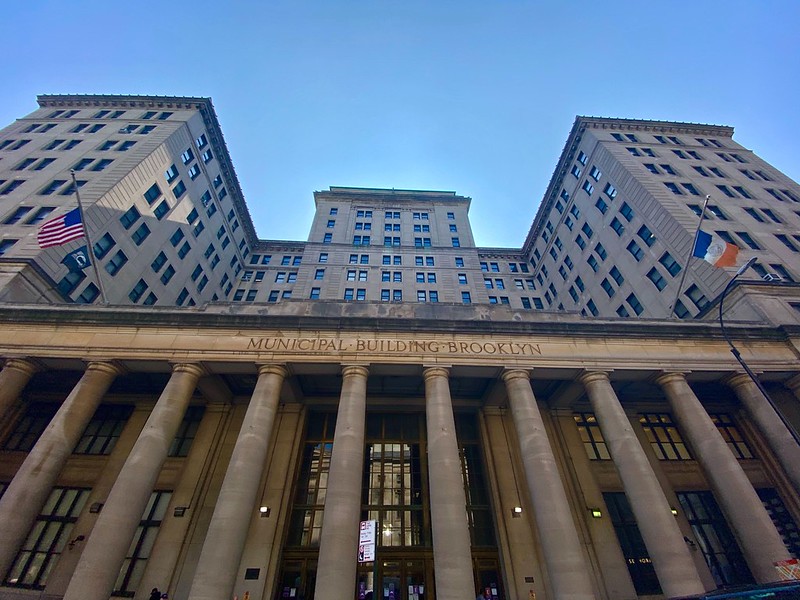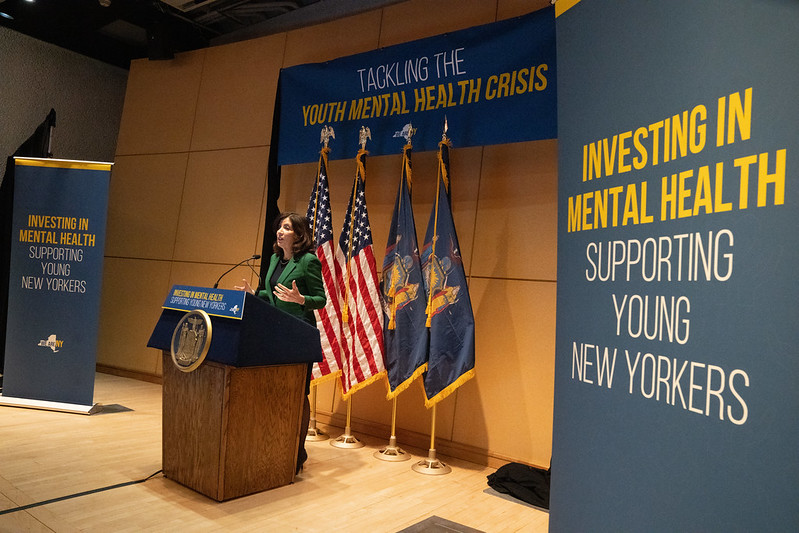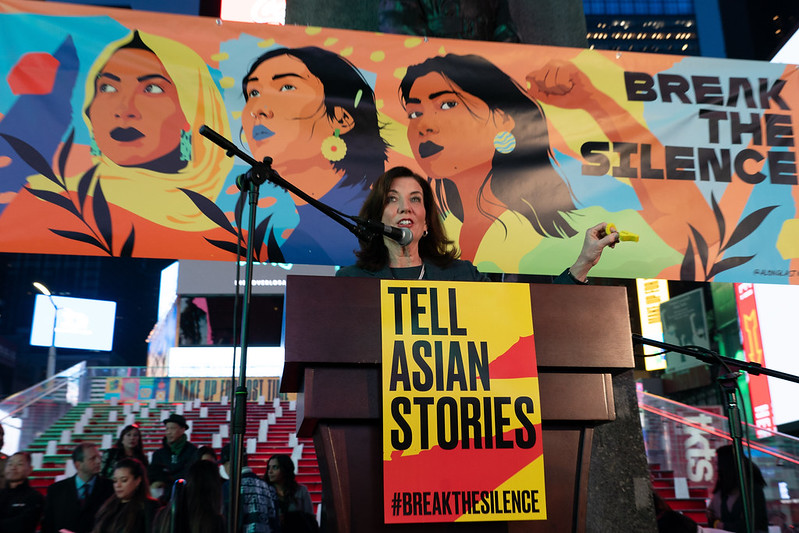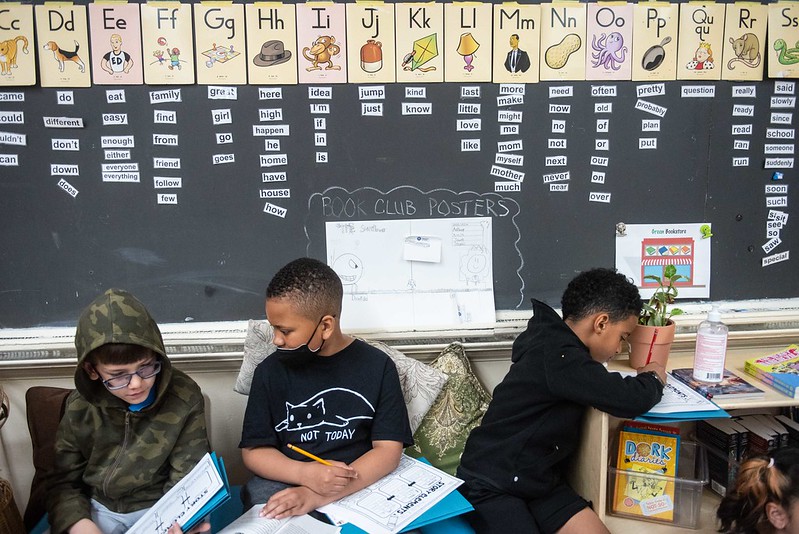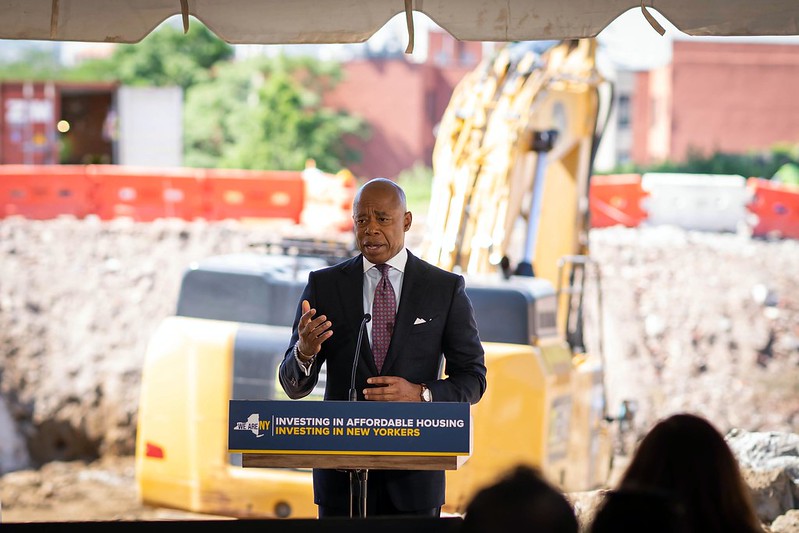
Mayor Adams talks housing (photo: Ed Reed/Mayoral Photography Office)
Once upon a time - also known as January 10 - Governor Kathy Hochul presented her vision for New York State. The centerpiece of her agenda was her New York Housing Compact, the most aggressive and ambitious plan to tackle the housing crisis in recent memory. The compact had flaws — tenant protections and affordability benchmarks were largely absent in the proposal. But the plan to mandate municipalities increase their housing supply and a target goal of building 800,000 units in a decade were right on track. They are appropriate positions to meet the needs of solving our housing crisis head-on.
But four months later, the compact is still only a proposal, as both houses of the State Legislature refused to come to agreement on its key components during state budget negotiations. The only real push in recent memory to address New York’s housing shortage has at best been stalled, and any major efforts from Albany to address the housing crisis will likely not happen until next year, and that is no guarantee.
But this does not mean nothing can be done to solve our housing crisis this year. Just because state government was unwilling to address the housing crisis does not mean New York City Hall has to sit idly by and concede defeat. With the state's inability to deliver solutions, now is the time for New York City to step up and act on its initiatives to address our crippling housing shortage and rising rents. Fortunately, there are positive signs from city leaders and a handful of proposals in the offing.
Hochul’s goal to produce 800,000 units of new housing statewide in the next decade might be on pause, but Mayor Eric Adams’ benchmark of 500,000 new units of housing in New York City in that time is still alive. The mayor’s effort is in part reliant on state action that is not yet happening, but there is still a good deal the city can control.
It is a high bar to clear, as it would be the highest rate of housing production since the 1920s — but with the supply shortage in the city, a bar of that caliber is necessary. In December, the Adams administration outlined this vision in his Get Stuff Built plan, with over a hundred proposals designed to speed up and streamline housing construction. These proposals — from expediting the pre-certification process for rezoning applications to adjusting the environmental review process and standards — are necessary to get more housing in the pipeline and to make new housing production feasible.
With his Get Stuff Built plan, the City of Yes: Housing Opportunity zoning text amendment in development, and more, Mayor Adams has meaningful housing initiatives in his arsenal. Given the state taking a back seat on housing, these plans are needed more than ever. Adams should move aggressively to push these proposals, as well as initiating additional neighborhood rezonings — something that he has been rather quiet on in his tenure.
Mayor Adams is not the only one to pitch aggressive proposals, and he should take up willing partners. Manhattan Borough President Mark Levine has identified more than 170 sites across Manhattan to redevelop for housing as well as 9 sites for rezoning to accommodate more housing stock, which he says would result in 73,000 new units of housing. His plan was so popular that instead of the backlash he may have expected, Levine received suggestions from residents pointing to additional locations they thought new housing should rise.
Levine has provided a framework for every borough president to address housing shortages in their borough, and while none has yet to perform the same type of study, several others have professed their commitment to housing growth and are taking steps toward making it happen.
Even a couple of community boards have jumped on the trend of standing for more housing — an encouraging sign, considering the track record of community boards being hostile towards new development. Manhattan Community Board 4 released a proposal that would inject tens of thousands of new housing units. And Manhattan Community Board 2, which had previously opposed the SoHo rezoning, implied that it wants to see an increase in the size of 388 Hudson Street, a 100% affordable housing development in the West Village.
For progressive legislators, one of the sticking points of the governor’s Housing Compact was its lack of tenant protections. Fortunately, a handful of tenant provisions are floating around City Hall, and already enacted measures are ripe for reinforcement.
The Fair Chance For Housing Act is currently before the City Council; it would bar landlords from discriminating against prospective tenants with criminal background checks, giving many more people, especially people of color, a better chance at good and stable housing. There are also existing programs, like Right to Counsel, experiencing chronic funding issues. Without the proper funding for Right to Counsel, eviction cases and vulnerable tenants slip through the cracks. Patching those holes could provide many vulnerable tenants fair representation in court and the opportunity to stay in their homes.
While the State Legislature might be content with the status quo, the conversation around housing is changing in the city, and the seeds for meaningful improvement already exist. More aggressive action is needed, but there are several proposals that form a good start. Now is the time that ideas, proposals, and goals to alleviate the housing crisis must be turned into action.
But there is little by way of tangible legislation where it is needed. Despite many city leaders endorsing the Housing Compact, not much pressure has been applied to implement local solutions. Mayor Adams must quickly move his housing plans into action and show the public the results along the way, continuing to build support for advancing solutions. The City Council should also move to protect current and prospective tenants, implement the fair housing framework recently released by Speaker Adrienne Adams and Council members, and ensure that the next city budget includes essential funding for housing in many avenues, from affordable housing subsidies to tenant vouchers to staffing at key agencies.
It is important to remember that all the solutions the city could pass will not be enough. The lack of tenant protections is a fair critique, but Hochul’s Housing Compact offered a chance at real progress. Albany has the power to make sweeping changes to make it far easier for municipalities to solve the housing crisis.
That includes the broader planks of Hochul’s plan to require housing growth everywhere, especially around mass transit hubs, but also important specific policies like eliminating the Floor Area Ratio (FAR) cap on residential development in the city and legalizing accessory dwelling units. The lack of these policies will continue to hamper our ability to add much-needed supply to our housing stock.
The spotlight was shone brightest on the suburbs and vocal resistance to the plan, but New York City’s zoning landscape would have seen major changes too. While Hochul has said she will continue to fight for a housing plan in the future, advocates must continue to push for holistic changes at the state level. But it would be a tremendous disservice to vulnerable tenants and prospective residents if the city continues to wait for Albany to flip the switch.
Rents are still rising and flirting with records, the Rent Guidelines Board is considering significant increases on rent-stabilized apartments, more people cannot afford their rent comfortably, and housing construction is slowing. Even if City Hall is acting with one hand tied behind its back, our leaders need to do everything they can to keep people in their homes and get new homes built. The one hand the city does have accessible can still make meaningful changes to reverse these trends.
City leaders endorsing the Housing Compact is a good sign, but they cannot simply pass the buck to Albany or throw up their hands about the lack of state-led progress. As the old saying goes, If you want something done right, do it yourself.
***
Austin Celestin is a rising senior at New York University studying Urban Design and Journalism.
***
Have an op-ed idea or submission for Gotham Gazette? Email This email address is being protected from spambots. You need JavaScript enabled to view it.

